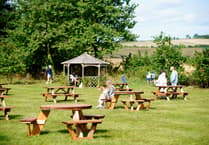On a hot evening, Carrie Packenham arrived with a car loaded with potted plants, an indication of her passion for herbs. She informed the club that her main reason for growing them was the history of their use.
By widening her definition from the usual one of plants grown for culinary or medicinal use to that of ‘any plant, tree or shrub which you can use’ she discussed plants like woad (blue dye) and weld or dyers rocket (orange dye). Some of our Christmas traditions are an extension of pagan beliefs that holly could ward of evil with its prickles and that evergreen ivy was a strong, protective plant.
Passing round posies for the audience to identify, Carrie picked out the scented pink blossoms of soapwort, which even today the National Trust uses to wash delicate old fabrics although it apparently takes some time and dedication to extract the ‘soap’ from the roots of the vigorous shrub.
Many flowering herbs such as santolina, ladies bedstraw, and lavender, were used on medieval floors as strewing herbs to overpower any whiffs and as replaceable carpets. Southernwood was used in nosegays – this evergreen bush with leaves reminiscent of yew would have been especially effective given that it is now recognised to have antibacterial properties.
Garlic of course is well-known for its immune boosting properties and effectiveness in treating coughs and colds. Somewhat more palatable would be the cough medicine Carrie has used for her own children, comprising equal quantities of blackberries, and elderberries gently simmered, then strained through muslin before being warmed through with a spoonful of honey, and perhaps lemon juice, before bottling.
Continuing with the medicinal theme Carrie noted that sphagnum moss, has long been used for bandaging wounds and was on a list of plants the population was asked to gather for use on the front during the First World War: it has also been used as nappies.
Rosehips were also gathered to provide vitamin C in the absence of citrus fruits. Cautioning against self-medication, Carrie mentioned that both foxglove and valerian extracts have sedative properties, and that aconite could provide relief from joint or nerve pain. Tansy, a yellow-flowering plant is a useful fly-repellent when cut and hung in bunches, for example in a kitchen.
Carrie demonstrated how to take cuttings from a variety of plants whilst discussing the value of steeped Comfrey as a fertiliser, and that Borage can help tomatoes to ripen as well as providing lovely little blue flowers that bees adore, and which are often used to decorate Pimms. Many herbs can be divided up and repotted, and a useful gift is to provide a selection of herbs in a pot underplanted with bulbs. Her homemade jellies and copies of her book on jelly making were also on sale.




Comments
This article has no comments yet. Be the first to leave a comment.